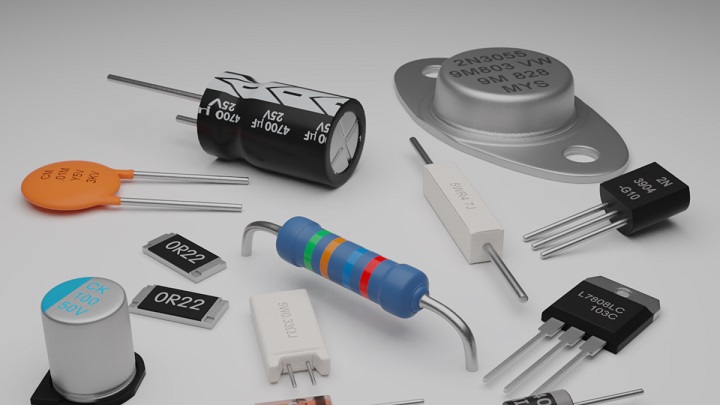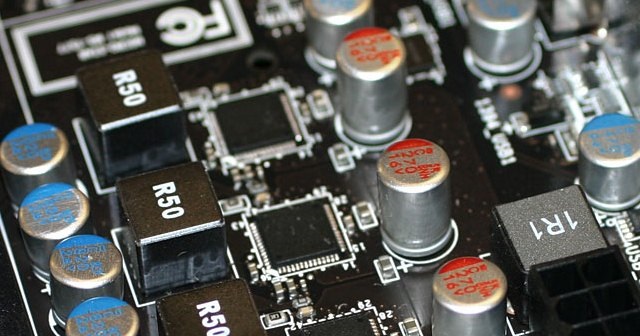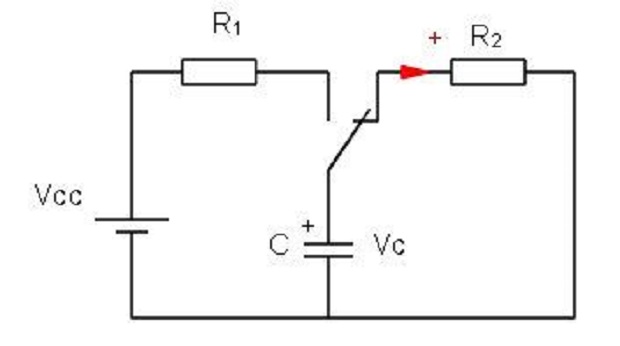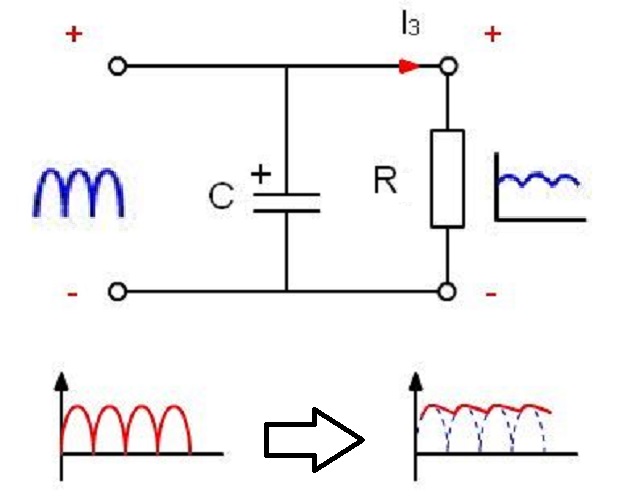The world of electronics has been the springboard that technology needed to be propelled. And this springboard is made up of small parts like the condenser. In this curious post you will learn in detail What is an electric capacitor?, The different functions that are applied with it and its great importance in different areas.

Condenser
To start the study of the capacitor, we will first explain what is a capacitor. It is a passive electrical component, that is, it does not generate electricity on its own, capable of storing an electrical charge, and releasing it later. You can find him as capacitor or capacitor. The charge that it maintains inside is a potential or voltage differential.
The story of the donor count arises in the year 1745 when the German Ewald Georg von Kleist realized that the storage of an electrical charge was possible. This arose as a result of an accident when he connected an electrostatic generator to a volume of water that was inside a glass jug or bottle using a cable. When he removed the cable and put his hand on it.
Not a year passed when the Dutch physicist Pieter van Musschenbroek invented a capacitor with the same characteristics. In commemoration of the university where he worked he called this condenser "the Leyden bottle."
How does a capacitor work?
Now lets see how a capacitor works y what is a capacitor for. The way in which it manages to store the electrical charge is by using two sheets made of conductive material, such as tantalum, which are separated by some dielectric material, for example air.
Before continuing, it is important not to confuse a dielectric with a fully insulating material. That is, all dielectrics are insulators, but this does not necessarily make all insulators dielectric. Dielectric materials have the ability to become conductive when subjected to a large electrical charge and break the dielectric strength. Some of these materials can be: ceramic, paper, wax, glass, oil, among others. Fully insulating materials are those that, regardless of how much electrical charge is subjected, this will not be a conductor, an example is rubber.
Now, the plates inside the capacitor, being fed with a power source, will be electrically charged in equal parts but with different signs. This means that one charge will be positive (+ q), and the other charge will have the same magnitude but with a negative charge (-q), at these equal charges but different signs is what is called the difference in potential or voltage.
In general, in capacitors air, paper, tantalum, aluminum and ceramics are used as dielectric material, also, in some capacitors certain plastics are used.
The storage capacity that a capacitor or capacitor has is calculated in the unit of Farads. The range in which most electrical capacitors are found are from pico (pF) to micro (uF) Farads. The equation to calculate the capacity of a capacitor is:
C=q/V
Where:
q = is the charge that each plate stores. Its unit is Coulomb (C)
V = is the voltage, voltage or potential differential between the two sheets or conductors of the capacitor. Its unit is Volts (V)
Applying this formula, if we assume the values for load 1 and for voltage 1, it would give us 1 Farad. However, this is just an example, as a capacitor of this capacity does not exist because it would be incredibly large. To get an idea, it would cover the space of 1000 m2.
Now, if we want to know the voltage that a capacitor can store knowing the charge and the Farads of the capacitor, then we can solve the Voltage from the previous equation being:
V=q/C
Charging and Discharging a Capacitor
One of the characteristics of the capacitor is that its discharge is progressive and not immediate. A capacitor has a discharge time period. This property allows the capacitor to have other applications such as timers and filters in an electrical circuit.
When a capacitor is fully charged, it is when it allows the voltage to pass. When the power supply is disconnected, the capacitor begins to gradually release the voltage towards the load or the element that consumes the voltage.
Generally, the capacitor is always preceded by a resistor for capacitor protection reasons. Even when a capacitor has a small internal resistance, it is negligible, and if care is not taken to protect the capacitor, it can be damaged and even explode.
Capacitor Charge
In order to simply explain the behavior of a capacitor when charging, we will use the most used example to illustrate it:
Let's consider a circuit where there is a power source such as a battery, a resistor named R1 that is responsible for controlling the flow of current that will reach the capacitor in order to protect it. Also, a switch that allows the capacitor to charge or discharge, and finally, a resistor called R2 which will represent the device that consumes the current.
In the first place, we see how the switch is arranged so that the capacitor is in series with the power supply and the resistance, by the way, we must emphasize that this resistance is called a load resistance.
At this moment the capacitor is being charged in a controlled way thanks to the charging resistor. This combination of resistor and capacitor allows you to set the timers that we mentioned earlier. This is due to the fact that the resistance prevents the passage of current freely, so the current takes longer to travel through the circuit, so that then it passes through the capacitor, it takes a while to charge.
The time it takes for a capacitor to charge can be calculated using the following equation:
t1 = 5 x R1 x C
Where:
t1: is the charging time. Its unit is milliseconds (me)
R1: is the load resistance. Its unit is ohms (Ω).
C: is the capacitance of the capacitor. Its unit is Farads (F)
This equation allows us to affirm that the higher the load resistance and / or the greater the capacitance of a capacitor, the longer the charging time. Which can be verified in the following graph.
You might wonder what would happen if we don't put the load resistor on. Theoretically the capacitor would charge immediately. But, as we mentioned earlier, this is not recommended as capacitors can only receive a small current. If we remember Ohm's Law we can see that:
I=V/R
Where:
I: is the current. Its unit is Amperes (A)
V: is the voltage. Its unit is Volts (V)
A: it is resistance. Its unit is the Ohm (Ω)
If the resistance tends to or is equal to 0, this would imply that the current would be practically infinite, or at least very large. The capacitor can only support feeding from a lower current. In short, if no type of load resistor is placed, the capacitor may not be able to withstand that current and will burn out.
Now let's assume the capacitor has already charged, so what happens? Let's go back to Ohm's Law, as the voltage rises, and since the value of the resistance is maintained, the value of the current tends to zero.
As we already know, the function of the capacitor is to store voltage or voltage. This means that as the capacitor charges, there is a higher voltage at that point. Since the resistance does not change its value, the current tends to zero. In short, once a capacitor is charged, it behaves like an open circuit or like a switch that prevents the passage of current, although there will be voltage or voltage at that point.
Condenser Discharge
Now let us present the inverse case. The moment the switch changes position, and the capacitor is placed in series with resistor R2, the capacitor will begin to discharge. Why? Well, because the resistance R2 represents the consumption of the circuit, and this resistance will demand to be supplied when the circuit in which it is closed. This supply will be provided by the capacitor, discharging the potential difference that it has stored.
As with charging, the download is not immediate, but progressively. And as with charging, the equation for estimating discharge time is the same. This means that the time it takes to discharge the capacitor depends on the resistance of R2 and the capacitance of the capacitor. Likewise, here we refresh the equation again:
t1 = 5 x R1 x C
Where:
t2: is the charging time. Its unit is milliseconds (ms)
R2: is the load resistance. Its unit is ohms (Ω).
C: is the capacitance of the condenser. Its unit is Farads (F)
This type of circuit could control, for example, the time a device is on.
The Condenser as a Filter
Another of the applications for which capacitors are frequently used is as a filter. This is possible thanks to its characteristic of charging and discharging gradually, and this phenomenon is used to clean impurities from the signals or the electrical wave.
If we take the initial circuit as an example, but in this case with an alternating current power supply. The capacitor will begin to charge until it reaches its maximum storage capacity, then the flow of current will cease and the load will begin to be supplied by the voltage that exists in the capacitor. As soon as the capacitor begins to discharge, the power supply proceeds to recharge the capacitor without waiting for it to discharge completely.
This can be visually easier to understand:
As can be seen, the wave of the alternating power supply is sinusoidal and thanks to the property of the capacitor it is possible to rectify the wave in a direct supply. This is very useful for power supplies used by, for example, computers. Many devices cannot work with alternating current but with direct current and that is when the power supplies enter as an intermediary. Of course, these power supplies have many more components to achieve this goal.
Types of Capacitors
Capacitors or capacitors can have different classifications. Next, we will begin by classifying capacitors according to their type of dielectric:
Because of its dielectric
Capacitors are classified according to the dielectric they have. There are so-called electrolytic capacitors, they are those that have a polarity, that is, they have a positive terminal or "leg" and a negative terminal. If they are connected with the polarity reversed, the capacitor will be damaged.
These electrolytic capacitors, unlike other capacitors is that they use a conductive ionic liquid. This liquid is a chemical solution, which is commonly composed of boric acid or sodium borate with ethylene glycol sugars. This liquid enters as a substitute for one of the conductive plates or sheets of the condenser.
Unlike electrolytic capacitors, capacitors whose dielectric is air, ceramic, paper, or others, do not have a set polarity. In addition, they have two plates inside and no internal liquid.
Both types of capacitors have their applications, so it has not been possible to substitute the capacitors with each other even though they have different dielectrics.
In short, there are condensers:
- Electrolytic
- Ceramics
- Of paper
- Of air
- Variable capacitor
Fixed or variable
Like resistors, there are capacitors with a fixed capacity and also capacitors whose capacity can be varied. This is achieved by adjusting the gap between their plates using a knob, such as a potentiometer or a variable resistor.
According to its shape
The condensers can vary their design, existing disk, pearl and tubular condensers, as shown below respectively.
Capacitors Code
There are some capacitors that indicate their capacity value by means of a color table, very similar to the one used by resistors.
Color code
The first color indicates the value of the first, the second that of the second figure, the third is the exponent that raises to 10, that is, 10 will be raised to the number that the third color represents. The fourth color indicates the percentage of variation, that is, it can be, for example, 10% more or 10% to the value that indicates the capacity. Lastly, the fifth color indicates the charging voltage or voltage. All these capacitors have picofarads per unit.
The value of the colors comes in a commercial table that is the following:
Japanese code
There is another type of code to identify the capacitance of a capacitor is a type of code called the Japanese code or code 101. This code consists of three numbers that are visible on the capacitor.
The first two digits form a number that must be multiplied by 10 raised to the third number, keeping the picofarad as a unit. For instance:
This capacitor has by code the numbers 104. So the way to calculate the capacity of this capacitor is:
X 10 104 = 100000 pF = 0,1 uF
Alphanumeric code
There is another code to identify the material and capacity of a capacitor, which uses the combination of letters and numbers. There are many ways to present this code that combine numbers and letters, and they are so varied that it is not really worth learning them, so it is recommended instead to consult the manufacturer's Datasheet.
Capacitors in series and in parallel
Like the resistors, the position of the capacitors in series or in parallel generates a behavior in the total capacitance. Let's start to look at the phenomenon that happens when capacitors are in series.
Capacitors in Series
When capacitors are in series, the capacity of each capacitor acts as follows:
The equation arises:
Vt = V1 + V2
Where:
Vt: total voltage
V1: voltage of the first capacitor
V2: voltage of the second capacitor
Let's go back to the equation to calculate the capacitor capacity:
C=q/V
Where:
q = is the charge that each plate stores. Its unit is Coulomb (C)
V = is the voltage, voltage or potential differential between the two sheets or conductors of the capacitor. Its unit is Volts (V)
And that it was possible to clear V in the following way:
V=q/C
Now, if we replace each V of each capacitor in the circuit by the previous expression, we obtain that;
1 / C = 1 / C1 + 1 / C2 + 1 / C3… 1 / Cn
Parallel Capacitors
In this case, since the capacitors are in parallel, the voltage that each capacitor receives is equal to that of the power supply, so it has to:
Vt = V1 = V2 = V3… Vn
Where
Vt: is the total or source voltage
V1: Voltage of the first capacitor
V2. Second capacitor voltage
V3: Voltage of the third capacitor
Again, if we return to the expression that allows us to estimate the voltage value according to the load and the capacity value:
V=q/C
And we proceed to replace each V of each capacitor of the circuit by the previous expression, we obtain that:
C = C1 + C2 + C3… + Cn
Condenser uses
The capacitor is one of the most basic components of electronics. It is almost impossible to mention a device today that does not require capacitors in its design. Next we will mention some of the most common applications where the capacitor is found.
- Batteries and memories: Thanks to its storage capacity, it is possible to place several capacitors in parallel to increase the charging capacity.
- Filters: They are widely used in electrical networks since they can eliminate the ripple and noise from the network, or in the reverse case, so that the harmonics generated by the internal electrical networks are filtered before returning to the network. In telecommunications, its filtering capacity is widely used to establish frequency bands and also to reduce or eliminate interference.
- Power sources: Its gradual charging and discharging behavior allows wave rectification, which is essential in power supplies to transform alternating currents into direct currents, since most electronic devices work internally with direct current, but electrical service operates with alternating current. That is why power sources are necessary for the operation of equipment, and among the components that make it up, the capacitor plays an irreplaceable role.
- Impedance adapters: Capacitors can discharge and charge energy in practically negligible periods of time, and this allows resistivity to resonate together with other components, so that two circuits having different impedances can be coupled or worked together.
However, these are just a few of its few uses that we can mention. Capacitors have applications in electronics, large electrical networks, telecommunications and others. From our computers, cell phones, refrigerators, digital clocks, televisions and many other inventions, they have capacitors inside as an essential part of the set that forms and gives life to devices or equipment.
Conclusions
The applications that electronics has today are so important in our daily lives that it is practically impossible to survive in a world where it no longer exists. And this vast world of advanced technology begins in its most humble foundations as are each component that is part of electronics.
This is the case of the capacitor, a component made of very simple materials, which makes it one of the basic components of electronics, but it is thanks to its behavior that it is impossible that it is not found in all the electronic devices that exist.
Undoubtedly, the advancement of electronics has been a fundamental driver that has paved the way for the advancement of technologies in various disciplines. And even though the condenser by itself is not very useful when combined with other components, sophisticated equipment such as RAM memory cards, computers, robots, drones, cell phones, servers and more.













